Updated: 15-Nov-2021
The “Societá Anonima Piaggio i Cia” was dedicated to the construction of rolling railway equipment and shipyard activities before 1916 when aeronautical activity began.
-The company was founded by Rinaldo Piaggio in 1884, and was based in Genova. The aero-engine department was located in Pontedera.
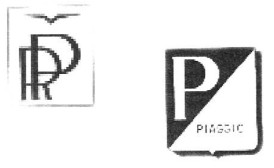
“Logos Piaggio”
-The first used logo is the one that includes the initials of Rinaldo Piaggio, the second one es from much later. That is the one we know from the first Vespa scooters.
-Piaggio started building Bristol engines under license, the 500 CV Jupiter VIII, and Gnome-Rhone before it began to produce its own engines.
-The Piaggio VII, was not a genuine design of the company, but a license from G-R, the K7. It was a 7-cylinder radial that gave between 370 CV and 510 CV, depending on the version.
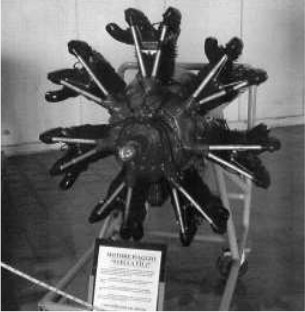
“Piaggio Stella VIIz”
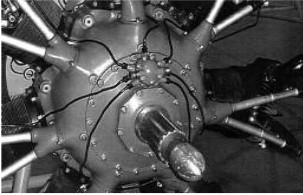
"Air distributor details"
-In this photograph we see the air distributor, working like a Delco, supplying the compressed starter air to each cylinder in the expansion stroke.
-Another curious photograph is the one of this same engine located at the Museum of Italian Aeronautics, in good company, because next to it is the double Fiat engine of the Schneider cup plane, the Macchi Castoldi MC-72.

“Stella VIIz in Vigna di Valle”
-The powers varied according to the version, the C-16 gave 460 CV and the C-35 and C-45 delivered 500 CV.
-These specific versions were also built by Reggiane.
-The VII series engines were known by the name of "Stella".
-But the P-VII R17/60, received the proper name of “Uragano”.
-The Piaggio IX also "Stella", were 9-cylinder radials giving 610 CV.
-They were installed on the Savoia S-79 and on the Siai-Marchetti “Sparviero” prototype in 1935.
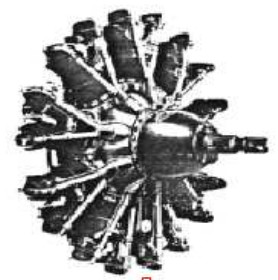
“Piaggio P-X, geared”
-The P-IX RCs gave 610 CV, the P-IX, P-X and P-XVI had all nine radial cylinders and gave between 625 and 700 CV.
-The P-X R was built under license from Isotta-Fraschini.
-They were used very much in Italian aviation such as Ro-43 and 44, Savoia 73, 74 and 81, Caproni 132, Ju-52, Cant Z-506, etc.
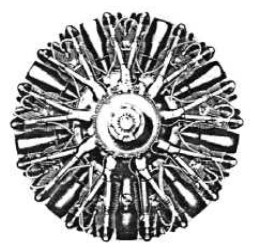
“P-X, front view”
-It was provided with a compressor. The "R" suffix indicates that the engine delivers its power at 1,000 meters, but the correct name will be “RC10”.
-The “RC35” version delivers its power at 3,500 meters.

“Piaggio P-XVI”
-The P-XVI with 9 radial cylinders gave 650 CV, in the RC35 version it maintains its power at 3,500 meters. thanks to a single-step, single-speed compressor.
-It was geared.
-The 14-cylinder, double-row radial engines were the P-XI and P-XIX.
-The geared P-XI RC40 gave the following powers to understand the compressor operation:
-At ground level it gave only 880 CV.
-At 4,000 mts. (RC40) it delivered the designated 1,000 CV and only 765 CV at 6,000 meters.
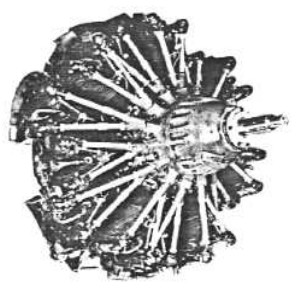
“P-XI RC40”
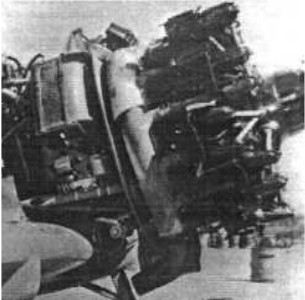
“P-XI RC40 on Reggiane 2000”
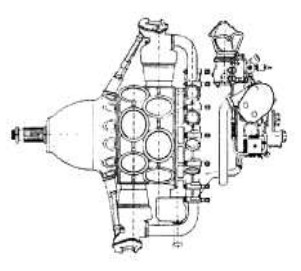
“P-XI, Piaggio P-XI, engine schematic”
-We see the schematics of the cylinder bearing block and the cavity that is required for the mounting of a double row radial engine, with a robust and counterbalanced crankshaft, master connecting rod and small rods.
-The crankshaft and the connecting-rod system of this same engine are shown below.
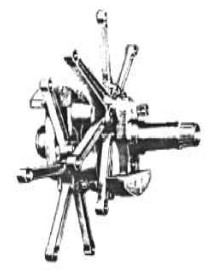
“P-XI connecting-rod system”
-There were other versions, such as the RC50, RC30, RC40bis, RC44, RC72 and RC100
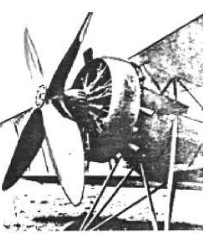
“For altitude record”
-The P-XI RC40 was installed on the Ca-161bis for an altitude record, in 1938.
-The propeller is extremely disproportionate, but apt to be effective in less dense air.
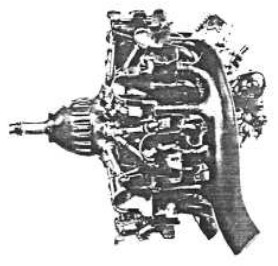
“P-XIX RC45”
-The P-XIX RC45 model is the one illustrated below and, like most Piaggio models, project engineer Aldo Spolti and, in the P-XIX, also engineer Eugenio Mancini, took part of it.
-It had 14 cylinders and delivered 1180 CV. The RC45B version was nicknamed "Turbine", without having more turbine but the supercharger.
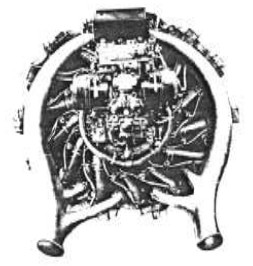
“P-XIX RC45, rear view”
-The RC60 version (for maintaining power at 6,000 meters), had a successful application in the beautiful Reggiane Re2002 airplane.
-The P-XII and P-XXII engines were 18-cylinder, double-row radials (approx. 1700 CV).
-In 1953, Piaggio built licensed piston engines of the Lycoming series such as the VO-435 and GSO-480 for Agusta the former and SIAI the latter.
And the O-435. Also from Avco Lycoming the T-53, T-55 and LT-101.

“Piaggio GEM-2”
-From Bristol-Rolls Royce they made the Vipers.
-The GEM 2 turboshafts (MK-1004), and the TRM-3322 were for the Agusta A-109 “Mangusta” and the A-129 helicopters.
-Another more powerful engine manufactured by Piaggio is the RR Spey 807.
-Now we do a chronological review of the brand's production:
-In the 1910's, Piaggio made a 26 CV 2-cylinder.
-In 1926, the formal construction of aviation engines began, acquiring the licenses of the Bristol Jupiter VI, VII and VIII.
-In the 1930's it made its major production with the Piaggio P-VII that gave powers of between 370 and 500 CV capable of maintaining power at altitude such as the RC-35 (3,500 meters) and RC-45 (4,500 meters).
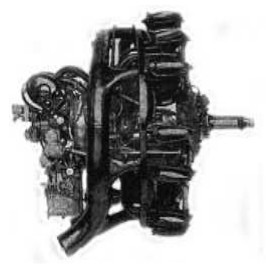
“Piaggio P-VII C45”
-The Piaggio P-VII had 7 radial cylinders and the P-IX, P-X and P-XVI had 9 radial cylinders.
-In 1933 the 600 CV P-IX R was made with the same power as the RC40, and the ability to keep them at altitude.
-A supercharged version with two speeds was the P-IX RC40/2v.

“Piaggio P-IX RC40”
-The P-X R, C and RC10, from the year 1936, gave 700 CV at 2,350 rpm. With a gearbox they maintained power up to 1,000 meters.

“Piaggio P-X R”
-The P-XI, from the same period in RC versions of 15, 40, 44, 50, 60, 72 and up to 100. In other words, the latter maintained its power up to 10,000 meters of altitude, but already with a two-speed compressor.
-The P-XIs had 14 radial cylinders in a double-row, and their power was 1,000 CV. The P-XVI RC35 had 9 cylinders and gave 650 CV. Year 1939.
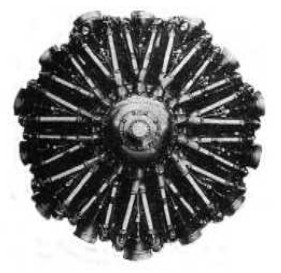
“Piaggio P-XI RC-40”
-The P-XIX were made from 1939 until the 1940's with 14 radial cylinders giving 1,180 CV.
-The P-XII had 18 radial cylinders and gave 1300 CV. It had an RC100 version with a two-speed compressor. The P-XV in RC45 and RC 60/2v. The former from 1940 and the later from 1942 giving about 1,500 CV. It was an 18-cylinder, double-row radial.
-Finally there was the P-XXI RC35 with 14 cylinders and giving 900 CV, while the RC100/2v was an 18-cylinder, double-row radial that gave 1600 CV. This was at the same time that the P-XVs were made. After the war Piaggio made licensed American engines as explained in the main text.

"Piaggio P.31M motor compressor"
-This Piaggio APU had a compressor and generator.
-And now two new views of the auxiliary power group P31M. It had two cylinders in V, and manual pull start. One cylinder is the engine with a two-stroke cycle. The other one is the compressor. At the same time it drives a generator.
-We can see all of this in the two views below.

“Puller side”

“P.31M”
From Appendix A1/6: From the Vigna di Valle Museum, JGB sends us two photographs of the Piaggio Stella VII and VIIz.

“Piaggio P-VII, Stella”
-In the VII of the photo, a NACA-type ring with lobes for each cylinder rocker box can be seen with the entire ring attached to the engine itself, and oscillating with it.
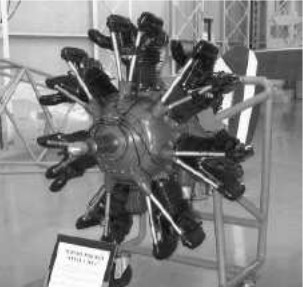
“Piaggio VIIz”
-The VIIz in the photo has a pneumatic starter as we can see from the “spider” and small front distributor.
From Appendix 9: In the Norwegian Museum in Malmö there is a Piaggio P-XI bis, a double row radial, clearly based on a Gnome Le Rhone.
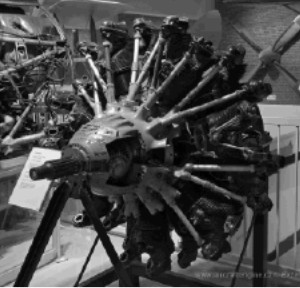
“Piaggio P-XI bis” (AEHS)
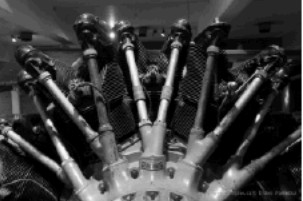
“Rod sleeves details”
-The strong inclination of the rear-row, rocker-arm control rods attracts a lot of attention.
-We know engines that in these cases have a front and a rear cam plate.
-It is necessary to refer to Gnome-Rhone to see how it works: First, the tracks of the cam plate are carved at an angle, so that the rollers of the pins already have a first angle, the rods come out of the pin with another more lowered angle, finally the attack at the end of the pin is made with another inclination greater than the usual one.
-Apart from Piaggio, the G-Rs have been built under license in many countries. So there is no doubt about the goodness of the device, strangely enough.
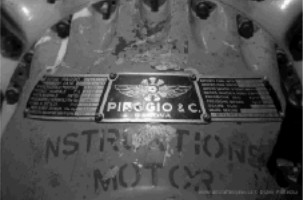
"Instruction plate on the gearbox"
Engines of PIAGGIO
Model: 2 cyl. twin-flat
Model: G-R K-7 (Lic.)
Arquitecture:
Cooling:
Total Displacement:
Bore / Stroke: x
Power:
Weight:
Model: GEM.2, turbina
Arquitecture:
Compressor/s:
Combustion chambers:
Turbines:
Power / Thrust: / ---
Weight:

"Piaggio GEM-2"
Model: Jupiter VI, VII, VIII (Lic. G-R/Bristol)
Arquitecture:
Cooling:
Total Displacement:
Bore / Stroke: x
Power:
Weight:
Model: P-31M (APP)
Power: Other details:

"Piaggio P.31M"
Model: P-IX, Stella.
Arquitecture:
Cooling:
Total Displacement:
Bore / Stroke: x
Power:
Weight:

"Piaggio P-IX RC40"
Model: P-VII, Stella
Arquitecture: 7-cylinder Radial
Cooling:
Total Displacement:
Bore / Stroke:
Power: 510 CV
Weight:
Powers between 370 CV and 510 CV, according to version.

"Piaggio VIIz"
Model: P-X, Stella.
Arquitecture:
Cooling:
Total Displacement:
Bore / Stroke: x
Power:
Weight:

"Piaggio P-X R"
Model: P-XI, Stella.
Arquitecture:
Cooling:
Total Displacement:
Bore / Stroke: x
Power:
Weight:

"Piaggio P-XI RC-40"
Model: P-XII, Stella. (18 cils. doble row)
Arquitecture:
Cooling:
Total Displacement:
Bore / Stroke: x
Power:
Weight:
Model: P-XIX, Stella.
Arquitecture:
Cooling:
Total Displacement:
Bore / Stroke: x
Power:
Weight:

"Piaggio P-XIX RC45"
Model: P-XVI, Stella.
Arquitecture:
Cooling:
Total Displacement:
Bore / Stroke: x
Power:
Weight:

"Piaggio P-XVI"


